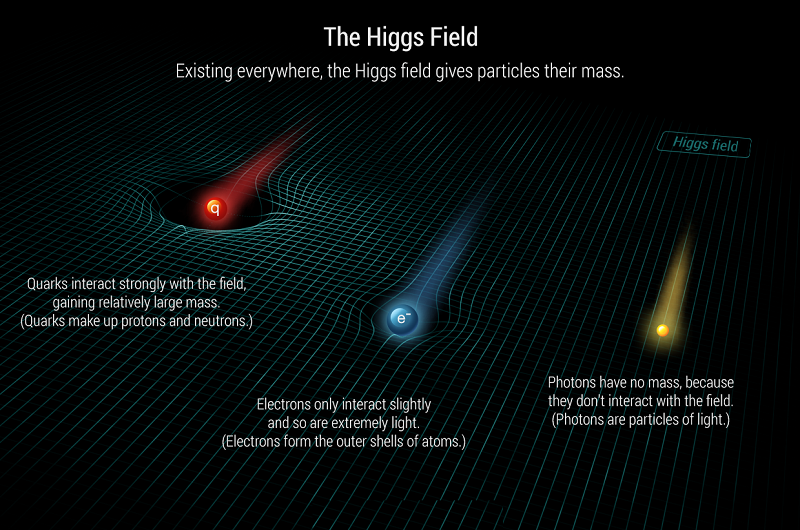Understanding - What Is Higgs Boson Or God Particle & What Are Its Salient Features
- Ananya Sharma

- Apr 11, 2024
- 4 min read
Updated: Apr 12, 2024
Hello, Everyone!
On the 4th of July 2012, the fundamental particle -Higgs Boson, was discovered by researchers after experiments were being done at the Large Hadron Collider (LHC) marked as the world's largest particle accelerator; at the European Particle Physics Laboratory (CERN) in Switzerland.
A particle accelerator is an apparatus leveraged to accelerate charged particles e.g.protons and electrons at very high speeds and energies. These accelerated charged particles are then made to either collide with other particles such as electrons, protons, neutrons, gluons, quarks, etc or they are made to collide at a specific target to help the scientists and researchers observe the fundamental properties of nature and the universe.
The eminent British Physicist Peter Higgs, Outlined a theory that the Higgs Boson is a fundamental force-carrying particle in the Higgs Field i.e. it is associated with the Higgs Field, and the field is owed to render mass to all fundamental particles like quarks and electrons. This field was initially theorized in 1964 by Peter Higgs; the name of which the particle was named.
Higgs Boson is one of the fundamental particles which enhances the basic framework of particle physics. The prevalence of the Higgs Boson in the universe can be predicted by its name God-Particle which outlines the pivotal role played by it in the sub-atomic physics.
Now let's delve into the intricacies of Higgs Boson.
Salient Features Of Higgs Boson:-
1. Mass: The mass of Higgs Boson is 125 billion Electron Volts which implies that it is 130 times more mass than a proton.
2. Chargeless: Higgs Boson is chargeless which implies it does not carry any electric charge. The charge of a particle in particle physics has a pivotal role in defining the behavior of a particle in electromagnetic fields.
3. Zero Spin: Higgs Boson has a spin of 0. Spin is the elementary property of particles in quantum mechanics, resembling angular momentum in classical mechanics. But spin is not the same as the angular momentum and it is the intrinsic angular momentum of a particle i.e. it is the inherent property of the particle without actually moving. Spin can take values such as 0,1/2,1 etc.
The Higgs Boson has a 0 spin, which details that it does not have intrinsic angular momentum in the usual sense.
Now let us understand the elementary particles called Bosons.
Bosons: The Bosons are the particles that have a unique characteristic of carrying forces or interactions between the particles. We can call them the messengers or carriers of these interactions. Whenever there is an interaction between the particles, the bosons are exchanged.
Let us understand them in detail.
->Carriers of Force: Bosons are messengers or mediators of interactions between the particles. They occur during the interaction of the particles.
->Behave Like Wave In A Field: A Boson can also be predicted as a wave by the quantum field theory-{which states that in the universe there are different types of fields such as electric field, magnetic field, the gravitational field; prevailing everywhere and at every instant of time.}For instance the photons{small particles of light as per the Photon Theory Of Light} are the wave in the electromagnetic field.
->The Higgs Boson -A special case of Boson: A well-known Boson is a Higgs Boson and its specialty lies in its emergence-it emerges from the Higgs Field, which is proposed to render mass to the particles. When there is a particle interaction in the Higgs Field, particles gain mass due to their interaction with the Higgs Boson.
->Types Of Interaction With The Higgs Field: Strong interaction of the particles with the Higgs Field leads the particles to acquire greater mass because they get slowed down in the Higgs Field. This phenomenon is termed as the Higgs Mechanism.
Some particles like electrons and quarks interact more strongly with the Higgs Field; however, all the particles do not interact strongly with the Higgs Field for instance Photons do not slow down when interacting with the Higgs Field, and also; they do not acquire mass due to a phenomenon known as Spontaneous Symmetry Breaking.
Let's understand this further. When the universe was in its initial phase-i.e. when it was in the process of forming there was extreme symmetry between the particles;and this symmetry implies that all particles should possess the same mass. However; as the universe gradually cooled down the symmetry between the particles broke. Therefore; even though the photons interact with the Higgs Field they do not acquire any mass and they continue to travel with the same speed and do not get stuck in the Higgs Field.

Pic Source: Ias express
Pic Source URL : https://www.iasexpress.net/higgs-boson-god-particle-lhc-future-hadron-collider-upsc/
Overall, we can say that Bosons are particles that act as mediators between particles i.e. they facilitate interaction between the particles and they have a vital role in understanding the forces of nature.
Till now we have understood that not all particles; interact strongly with the Higgs Field ,such as Quarks and Electrons.
But what are quarks? Quarks are the fundamental particles that form neutrons and protons and are located in the center of the atoms. The Quarks are never found to exist individually, they always combine to form bigger particles such as protons and neutrons.
The Quarks are tightly glued together by a strong force which is carried by particles known as Gluons which behave like glue to keep quarks intact.
There are different types of quarks and properties of how they interact with one another.
Conclusively, we can say that Higgs Boson and Higgs Field named after renowned British Physicist and Nobel Laureate Peter Higgs; help the world understand nature and the universe in a nuanced way.
Thank You.
References:












Very informative blog about how particles interact in the Higgs Field and how much it is important… well written post 💖💖✍🏻✍🏻☺️☺️☺️